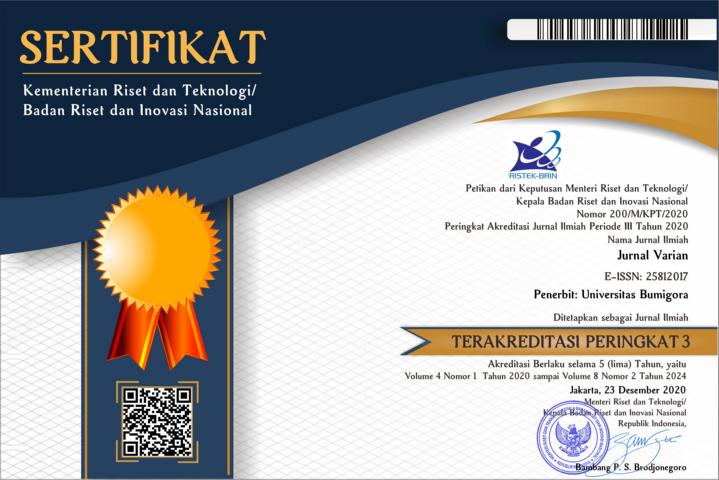The Sentiment Analysis Using Naã¯ve Bayes with Lexicon-Based Feature on TikTok Application
DOI:
https://doi.org/10.30812/varian.v6i1.2205Keywords:
Sentiment Analysis, Naïve Bayes, Lexicon Based, Tiktok, Google Play StoreAbstract
On TikTok application, there are several types of content in the form of education, cooking recipes, comedy, various tips, beauty, business, etc. However, some non-educational contents sometimes appear on TikTok homepage even though minors can access the app. As a result, TikTok application can influence the behavior of minors to be disgraceful, therefore, an assessment of the application can be one of the objects for conducting sentiment analysis. The purpose of this study is to compare the results of sentiment analysis on TikTok application using Naã¯ve Bayes with Lexicon-Based and without Lexicon-Based features. We used the TikTok reviews on Google Play Store as our data. According to the analysis, without Lexicon-Based feature, we obtained the accuracy rate, precision rate, and recall rate of 83%, 78%, and 69%, respectively. Meanwhile, the accuracy, precision, and recall rates using the Lexicon-Based feature were 85%, 91%, and 93%, respectively. Therefore, we concluded that sentiment analysis using Naã¯ve Bayes with Lexicon-Based feature was better than without Lexicon-Based feature on TikTok reviews.
References
without or with particle swarm optimization based on sentiment analysis whatsapp review. International Journal of Academic and
Applied Research (IJAAR), 6(6).
Catelli, R., Pelosi, S., and Esposito, M. (2022). Lexicon-based vs. bert-based sentiment analysis: A comparative study in italian.
Electronics, 11(3):374.
Choudhary, M. and Choudhary, P. K. (2018). Sentiment analysis of text reviewing algorithm using data mining. In 2018 International
Conference on Smart Systems and Inventive Technology (ICSSIT), pages 532–538. IEEE.
Gaur, N. and Sharma, N. (2017). Sentiment analysis in natural language processing. Int. J. Eng. Technol, 3:144–148.
Goel, A., Gautam, J., and Kumar, S. (2016). Real time sentiment analysis of tweets using naive bayes. In 2016 2nd International
Conference on Next Generation Computing Technologies (NGCT), pages 257–261. IEEE.
Kikuchi, M., Yoshida, M., Okabe, M., and Umemura, K. (2015). Confidence interval of probability estimator of laplace smoothing.
In 2015 2nd International Conference on Advanced Informatics: Concepts, Theory and Applications (ICAICTA), pages 1–6. IEEE.
Kundi, F. M., Khan, A., Ahmad, S., and Asghar, M. Z. (2014). Lexicon-based sentiment analysis in the social web. Journal of Basic
and Applied Scientific Research, 4(6):238–48.
Le, C.-C., Prasad, P., Alsadoon, A., Pham, L., and Elchouemi, A. (2019). Text classification: Na¨ıve bayes classifier with sentiment
lexicon. IAENG International journal of computer science, 46(2):141–148.
Mehto, A. and Indras, K. (2016). Data mining through sentiment analysis: Lexicon based sentiment analysis model using aspect
catalogue. In 2016 Symposium on Colossal Data Analysis and Networking (CDAN), pages 1–7. IEEE.
Mustofa, R. and Prasetiyo, B. (2021). Sentiment analysis using lexicon-based method with naive bayes classifier algorithm on#
newnormal hashtag in twitter. In Journal of Physics: Conference Series, volume 1918, page 042155. IOP Publishing.
Pertiwi, S. (2020). Pengaruh bauran pemasaran dan gaya hidup konsumen terhadap keputusan pembelian smartphone samsung (studi
kasus pada program studi manajemen stie mikroskil medan). Jurnal Wira Ekonomi Mikroskil, 10(1):45–56.
Setiawan, K. Y., Hidayati, H., and Gozali, A. A. (2014). Twitter user opinion analysis at fine-grained sentiment analysis level toward
public figure. In E-Proceeding of Engineering, volume 1, pages 639–646.
Wahyudi, D. and Sibaroni, Y. (2022). Deep learning for multi-aspect sentiment analysis of tiktok app using the rnn-lstm method.
Building of Informatics, Technology and Science (BITS), 4(1):169–177.
Wilantika, C. F. (2015). Pengaruh penggunaan smartphone terhadap kesehatan dan perilaku remaja. Jurnal Obstretika Scienta, 3(2).
Yusran, M., Rasyid, S., Sagita, E., Julia, R. N. D., et al. (2022). Sentiment analysis of sustainable development goals on twitter with
classifying decision tree c5. 0 and classification and regression tree. International Journal of Academic and Applied Research
(IJAAR), 6(6)





















